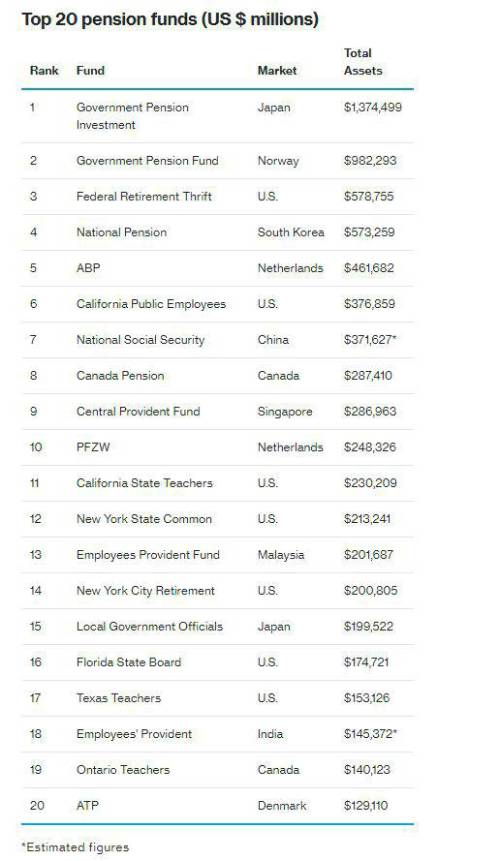The research, conducted in conjunction with Pensions & Investments, a leading U.S. investment newspaper, shows that the value of the top 20 pension funds’ AUM fell by 1.6% in 2018, equating to 40.7% of the total AUM in the rankings. This is the first year since 2012 that the top 20 funds’ share of the total AUM has fallen. However, the top 20 funds’ growth rate of 4.7% during the period 2013 to 2018 remained higher than the growth rate of 3.9% for the top 300 funds during the same period.
Bob Collie, Head of Research for the Thinking Ahead Group, said: “A tougher market environment in 2018 meant AUM growth paused, but the underlying trend remains one of growing pension markets worldwide. The pace of change in the investment world is a challenge, and scale is a huge advantage in a lot of ways. Many of the most interesting and important developments start with the largest funds, and as new investment ideas like the total portfolio approach and universal ownership gain traction in these organisations, they influence the whole market. It’s particularly notable that a majority of the largest funds are now highlighting the importance of sustainability. ESG factors are now significant financial considerations. Beyond that, there’s also an evolving recognition of the role large investors play within society, and the responsibility that comes with it.”
Among the top 300 funds, defined contribution (DC) assets increased by 5.1% during 2018, while defined benefit (DB) assets declined by 0.2%. DB funds account for 64.7% of the total AUM, with this share remaining unchanged from the previous year. However, the share of DB funds slightly decreased across all regions - with the exception of Europe where the same level was maintained. DB plans dominate in Europe, North America and Asia-Pacific where they represent 53.7%, 74.2% and 65.1% by assets respectively, whereas DC plans dominate 70% of assets elsewhere, particularly in Latin American countries.
The share of reserve funds (those set aside by a national government against future liabilities) decreased by 9.5%, whilst hybrid fund assets (those with both DB and DC components) decreased by 4.6%.
Sovereign and public sector pension funds account for 68.5% of the total AUM in the ranking, with 145 funds in the top 300. Sovereign pension funds represent US$5.1 trillion in assets, while sovereign wealth funds account for US$7.9 trillion.
North America remains the largest region in terms of AUM and number of funds, accounting for 45.2% of all assets in the research, followed by Asia-Pacific (26.2%) and Europe (24.9%). Asia-Pacific’s AUM and fund share has declined after several years of expansion, while Europe’s share has fallen to the lowest value in five years. During the same period, African and Latin American funds’ AUM increased by 0.7%. North America had the fastest annualised growth rate during the period 2013 to 2018 at 5.8%, while Europe and Asia-Pacific had annualised growth rates of 0.5% and 5.2% respectively.
A total of 26 new funds entered the top 300 in the last five years, with the US contributing the greatest net number of new funds (15). In contrast, Germany experienced the highest net loss of funds during the same period (6). The US continues to have the largest number of funds in the top 300 ranking (141), followed by the UK (24), Canada (17), Australia (16) and Japan (15).
On a weighted average for the top 20, assets are predominantly invested in equities (44.5%) followed by fixed income (37.2%) and alternatives and cash (18.3%). Regarding weighted average allocations by region, Asia-Pacific funds are predominantly invested in fixed income (53.8%), while North American funds are largely invested in equities (46.7%). European funds have demonstrated a more balanced allocation between equities and fixed income, at 49.1% and 36.2% respectively.
Denmark’s ATP re-entered the top 20 funds, having dropped out a year ago, and South Africa’s GEPF fell out of the top 20 to 21st place in the ranking.

|

